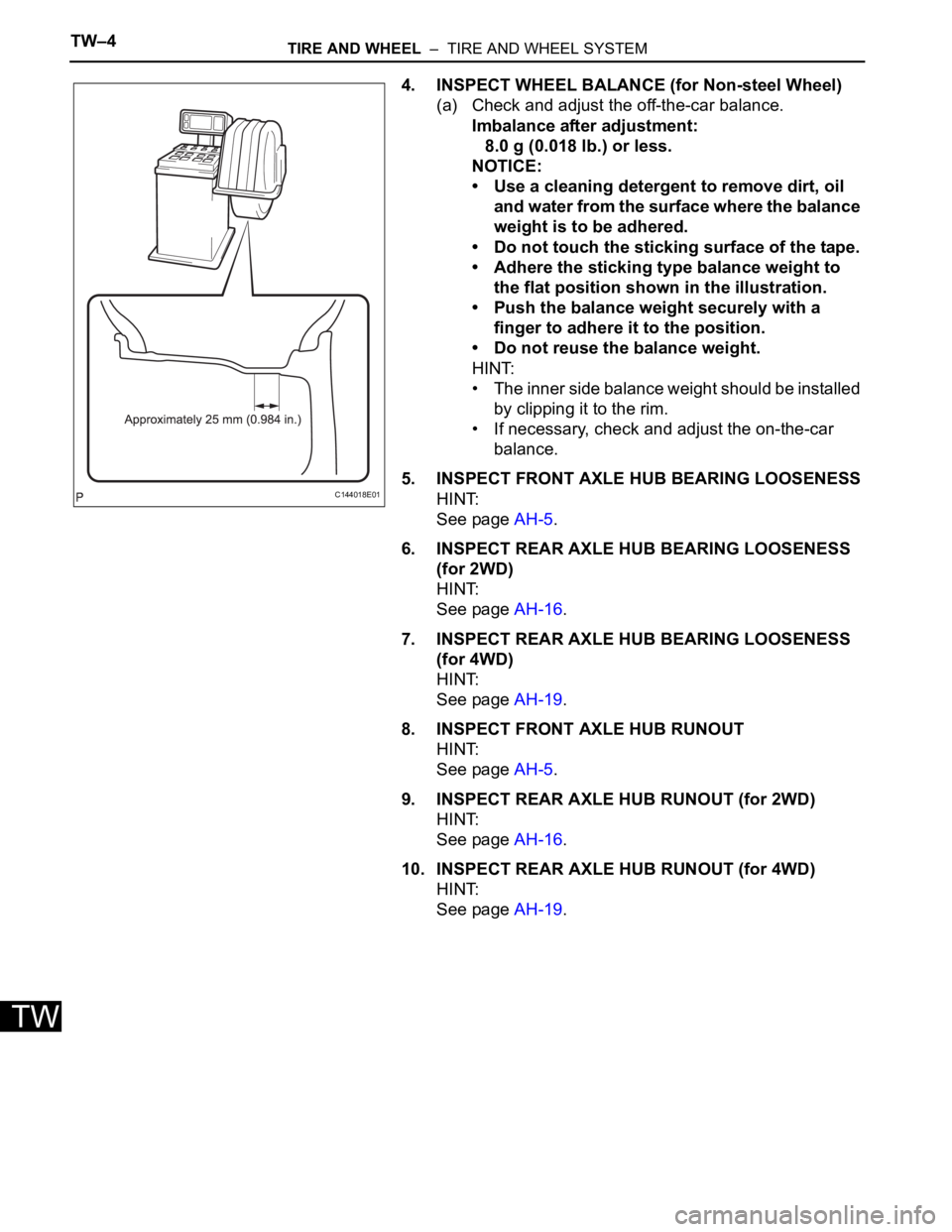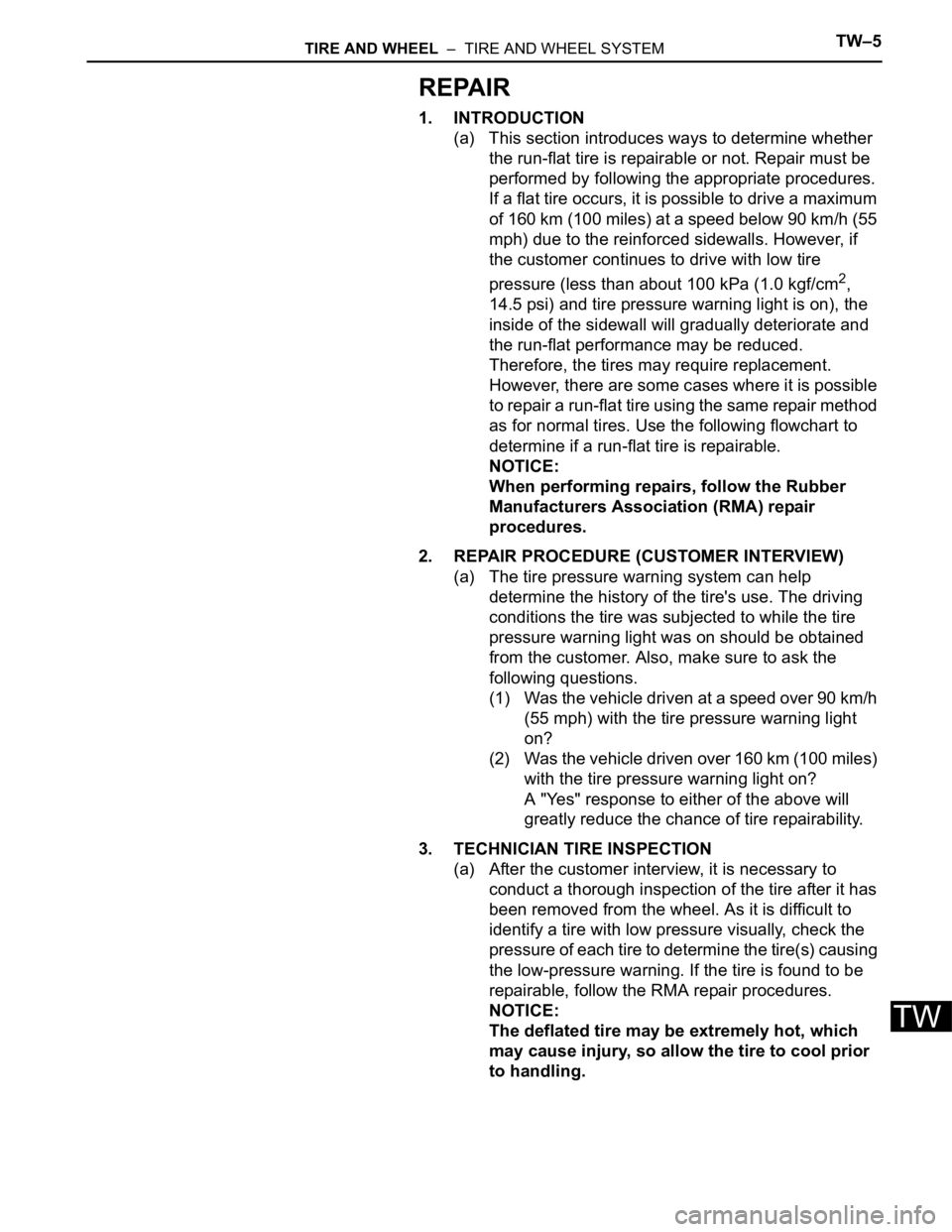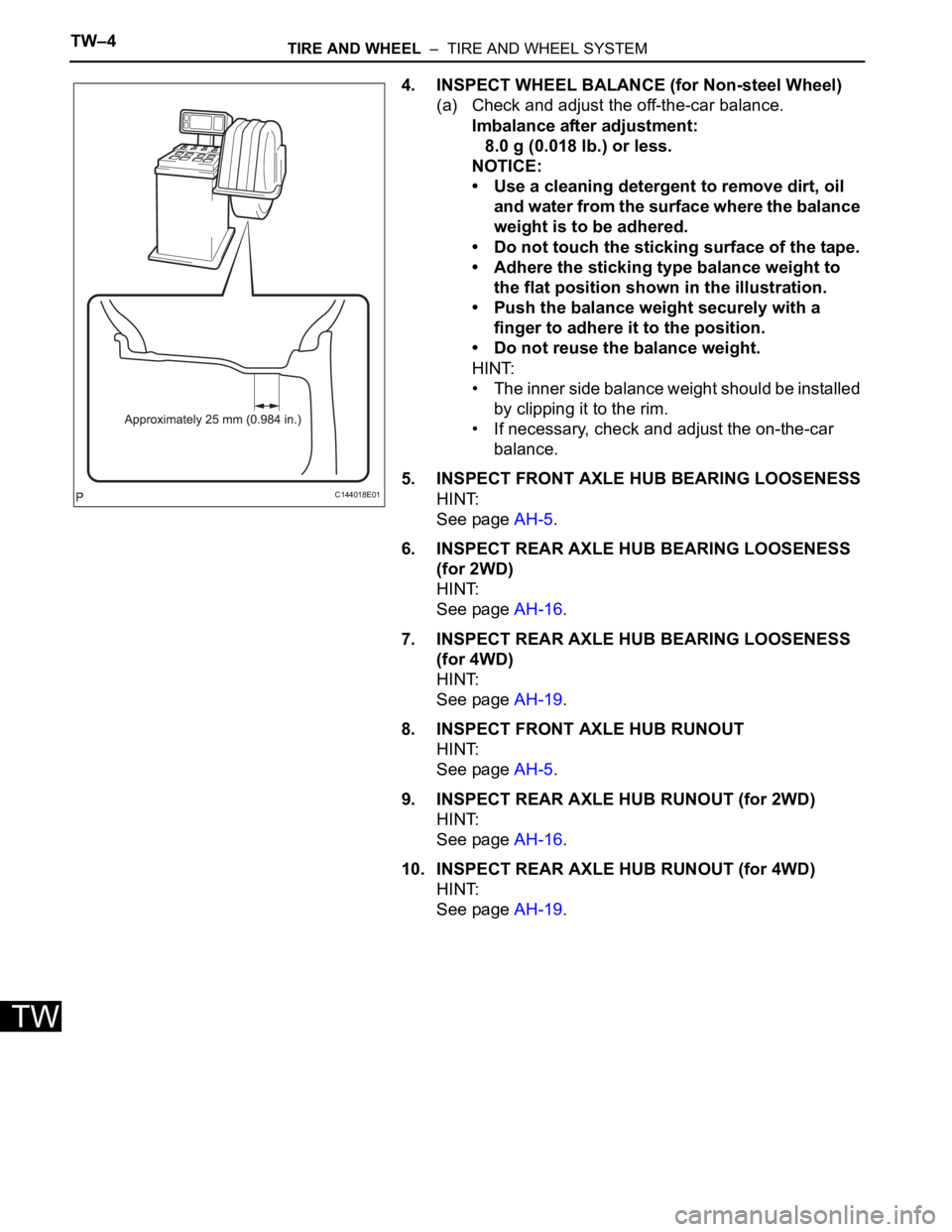Page 173 of 3000
TIRE AND WHEEL – TIRE AND WHEEL SYSTEMTW–3
TW
INSPECTION
1. INSPECT TIRES
(a) Check the tires for wear and proper inflation
pressure.
Cold tire inflation pressure
(b) Using a dial indicator, check the runout of the tires.
Tire runout:
1.4 mm (0.055 in.) or less
2. ROTATE TIRES
HINT:
Rotate the tires as shown in the illustration.
3. INSPECT WHEEL BALANCE (for Steel Wheel)
(a) Check and adjust the off-the-car balance.
Imbalance after adjustment:
8.0 g (0.018 lb.) or less.
HINT:
If necessary, check and adjust the on-the-car
balance.
Tire size
Front kPa (kgf*cm2, psi) Rear kPa (kgf*cm2, psi)
P215/65R16 96T
P225/60R17 98T240 (2.4, 35) 240 (2.4, 35)
C137874
C140312E01
C144019
Page 174 of 3000

TW–4TIRE AND WHEEL – TIRE AND WHEEL SYSTEM
TW
4. INSPECT WHEEL BALANCE (for Non-steel Wheel)
(a) Check and adjust the off-the-car balance.
Imbalance after adjustment:
8.0 g (0.018 lb.) or less.
NOTICE:
• Use a cleaning detergent to remove dirt, oil
and water from the surface where the balance
weight is to be adhered.
• Do not touch the sticking surface of the tape.
• Adhere the sticking type balance weight to
the flat position shown in the illustration.
• Push the balance weight securely with a
finger to adhere it to the position.
• Do not reuse the balance weight.
HINT:
• The inner side balance weight should be installed
by clipping it to the rim.
• If necessary, check and adjust the on-the-car
balance.
5. INSPECT FRONT AXLE HUB BEARING LOOSENESS
HINT:
See page AH-5.
6. INSPECT REAR AXLE HUB BEARING LOOSENESS
(for 2WD)
HINT:
See page AH-16.
7. INSPECT REAR AXLE HUB BEARING LOOSENESS
(for 4WD)
HINT:
See page AH-19.
8. INSPECT FRONT AXLE HUB RUNOUT
HINT:
See page AH-5.
9. INSPECT REAR AXLE HUB RUNOUT (for 2WD)
HINT:
See page AH-16.
10. INSPECT REAR AXLE HUB RUNOUT (for 4WD)
HINT:
See page AH-19.
C144018E01
Page 175 of 3000

TIRE AND WHEEL – TIRE AND WHEEL SYSTEMTW–5
TW
REPAIR
1. INTRODUCTION
(a) This section introduces ways to determine whether
the run-flat tire is repairable or not. Repair must be
performed by following the appropriate procedures.
If a flat tire occurs, it is possible to drive a maximum
of 160 km (100 miles) at a speed below 90 km/h (55
mph) due to the reinforced sidewalls. However, if
the customer continues to drive with low tire
pressure (less than about 100 kPa (1.0 kgf/cm
2,
14.5 psi) and tire pressure warning light is on), the
inside of the sidewall will gradually deteriorate and
the run-flat performance may be reduced.
Therefore, the tires may require replacement.
However, there are some cases where it is possible
to repair a run-flat tire using the same repair method
as for normal tires. Use the following flowchart to
determine if a run-flat tire is repairable.
NOTICE:
When performing repairs, follow the Rubber
Manufacturers Association (RMA) repair
procedures.
2. REPAIR PROCEDURE (CUSTOMER INTERVIEW)
(a) The tire pressure warning system can help
determine the history of the tire's use. The driving
conditions the tire was subjected to while the tire
pressure warning light was on should be obtained
from the customer. Also, make sure to ask the
following questions.
(1) Was the vehicle driven at a speed over 90 km/h
(55 mph) with the tire pressure warning light
on?
(2) Was the vehicle driven over 160 km (100 miles)
with the tire pressure warning light on?
A "Yes" response to either of the above will
greatly reduce the chance of tire repairability.
3. TECHNICIAN TIRE INSPECTION
(a) After the customer interview, it is necessary to
conduct a thorough inspection of the tire after it has
been removed from the wheel. As it is difficult to
identify a tire with low pressure visually, check the
pressure of each tire to determine the tire(s) causing
the low-pressure warning. If the tire is found to be
repairable, follow the RMA repair procedures.
NOTICE:
The deflated tire may be extremely hot, which
may cause injury, so allow the tire to cool prior
to handling.
Page 179 of 3000
TIRE AND WHEEL – TIRE AND WHEEL SYSTEMTW–9
TW
7. RUN-FLAT TIRE REPAIR LIMIT CHART
(a) Tires that have a penetration in the tread area but
meet the above inspection criteria may be repaired
if the guidelines listed below are also met.
Puncture condition (Tread area only)
C113008E01
Diameter (Maximum) Number (Maximum)Distance between holes
(Minimum)
6.4 mm (0.25 in.) 2 406 mm (16 in.)
Page 2122 of 3000

DF–24DIFFERENTIAL – REAR DIFFERENTIAL CARRIER
DF
(e) Align the matchmarks on the ring gear and
differential case.
(f) Temporarily install 4 new lock plates and 8 bolts.
(g) After the ring gear cools down enough, torque the 8
bolts uniformly.
Torque: 97 N*m (985 kgf*cm, 71 ft.*lbf)
HINT:
Tighten the bolts, in diagonal order, a little at a time
until they are all tightened.
(h) Using a chisel and a hammer, stake the 4 lock
plates.
(1) Stake one claw so that it is flush against the flat
surface of the bolt.
(2) As for the head so as to act as a stopper if the
bolt should start to loosen.
4. INSTALL REAR DIFFERENTIAL CASE BEARING RH
(a) Using SST and a press, install the case bearing
(RH) to the differential case.
SST 09636-20010
5. INSTALL REAR DIFFERENTIAL CASE BEARING LH
(a) Using SST and a press, install the case bearing
(LH) to the differential case.
SST 09636-20010
6. INSPECT RUNOUT OF DIFFERENTIAL RING GEAR
(a) Install the differential case to the carrier, and install
the 2 plate washers so that there is no play in the
bearing.
(b) Install the 2 bearing caps with the 4 bolts
Torque: 79 N*m (800 kgf*cm, 58 ft.*lbf)
(c) Using a dial gage, measure the runout of the ring
gear.
Maximum runout:
0.07 mm (0.0028 in.)
F003758E04
Z002483
F040347E01
F040463E01
C068116
Page 2146 of 3000

DF–24DIFFERENTIAL – REAR DIFFERENTIAL CARRIER
DF
(e) Align the matchmarks on the ring gear and
differential case.
(f) Temporarily install 4 new lock plates and 8 bolts.
(g) After the ring gear cools down enough, torque the 8
bolts uniformly.
Torque: 97 N*m (985 kgf*cm, 71 ft.*lbf)
HINT:
Tighten the bolts, in diagonal order, a little at a time
until they are all tightened.
(h) Using a chisel and a hammer, stake the 4 lock
plates.
(1) Stake one claw so that it is flush against the flat
surface of the bolt.
(2) As for the head so as to act as a stopper if the
bolt should start to loosen.
4. INSTALL REAR DIFFERENTIAL CASE BEARING RH
(a) Using SST and a press, install the case bearing
(RH) to the differential case.
SST 09636-20010
5. INSTALL REAR DIFFERENTIAL CASE BEARING LH
(a) Using SST and a press, install the case bearing
(LH) to the differential case.
SST 09636-20010
6. INSPECT RUNOUT OF DIFFERENTIAL RING GEAR
(a) Install the differential case to the carrier, and install
the 2 plate washers so that there is no play in the
bearing.
(b) Install the 2 bearing caps with the 4 bolts
Torque: 79 N*m (800 kgf*cm, 58 ft.*lbf)
(c) Using a dial gage, measure the runout of the ring
gear.
Maximum runout:
0.07 mm (0.0028 in.)
F003758E04
Z002483
F040347E01
F040463E01
C068116
Page 2254 of 3000
TIRE AND WHEEL – TIRE AND WHEEL SYSTEMTW–3
TW
INSPECTION
1. INSPECT TIRES
(a) Check the tires for wear and proper inflation
pressure.
Cold tire inflation pressure
(b) Using a dial indicator, check the runout of the tires.
Tire runout:
1.4 mm (0.055 in.) or less
2. ROTATE TIRES
HINT:
Rotate the tires as shown in the illustration.
3. INSPECT WHEEL BALANCE (for Steel Wheel)
(a) Check and adjust the off-the-car balance.
Imbalance after adjustment:
8.0 g (0.018 lb.) or less.
HINT:
If necessary, check and adjust the on-the-car
balance.
Tire size
Front kPa (kgf*cm2, psi) Rear kPa (kgf*cm2, psi)
P215/65R16 96T
P225/60R17 98T240 (2.4, 35) 240 (2.4, 35)
C137874
C140312E01
C144019
Page 2255 of 3000

TW–4TIRE AND WHEEL – TIRE AND WHEEL SYSTEM
TW
4. INSPECT WHEEL BALANCE (for Non-steel Wheel)
(a) Check and adjust the off-the-car balance.
Imbalance after adjustment:
8.0 g (0.018 lb.) or less.
NOTICE:
• Use a cleaning detergent to remove dirt, oil
and water from the surface where the balance
weight is to be adhered.
• Do not touch the sticking surface of the tape.
• Adhere the sticking type balance weight to
the flat position shown in the illustration.
• Push the balance weight securely with a
finger to adhere it to the position.
• Do not reuse the balance weight.
HINT:
• The inner side balance weight should be installed
by clipping it to the rim.
• If necessary, check and adjust the on-the-car
balance.
5. INSPECT FRONT AXLE HUB BEARING LOOSENESS
HINT:
See page AH-5.
6. INSPECT REAR AXLE HUB BEARING LOOSENESS
(for 2WD)
HINT:
See page AH-16.
7. INSPECT REAR AXLE HUB BEARING LOOSENESS
(for 4WD)
HINT:
See page AH-19.
8. INSPECT FRONT AXLE HUB RUNOUT
HINT:
See page AH-5.
9. INSPECT REAR AXLE HUB RUNOUT (for 2WD)
HINT:
See page AH-16.
10. INSPECT REAR AXLE HUB RUNOUT (for 4WD)
HINT:
See page AH-19.
C144018E01